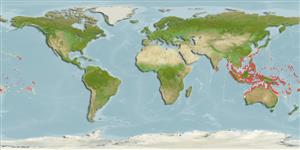Common names from other countries
Environment: milieu / climate zone / depth range / distribution range
экология
ассоциированный с рифами; пределы глубины 3 - 20 m (Ref. 8294). Tropical; 36°N - 31°S, 32°E - 137°W (Ref. 847)
Indo-Pacific.
Length at first maturity / Size / Вес / Возраст
Maturity: Lm ? range ? - ? cm Max length : 30.0 cm COLD самец/пол неопределен; (Ref. 269)
The coral is circular in outline, up to 30 cm in diameter. The upper surface is fairly rough due to moderate to deeply incised septal dentations on most septocostae, and the lower surface is rough due to costal spines (Ref. 269). The coral is circular in outline, up to 30 cm in diameter.
Maximum depth from Ref. 98471. Found at intermediate depths on reef slopes (Ref. 269). Also on back reefs, reef flats, and lagoons. Solitary, free-living (Ref. 98471).
Life cycle and mating behavior
половая зрелость | размножение | нерест | икра | Fecundity | личинки
Mature gametes are shed into the coelenteron and spawned through the mouth. Life cycle: The zygote develops into a planktonic planula larva. Metamorphosis begins with early morphogenesis of tentacles, septa and pharynx before larval settlement on the aboral end (Ref. 833).
Основная ссылка
ссылки | координатор | соавторы
Hodgson, G. 1998. (Ref. 269)
Статус Красного Списка МСОП (Ref. 130435)
Статус СИТЕС (Ref. 108899)
Not Evaluated
Использование человеком
| FishSource |
инструменты
дополнительная информация
Возраст/РазмерыростЗависимость между длиной и массой телаЗависимость между длинамиморфологияличинкичисленность
ресурсы в Интернет
Estimates based on models
Preferred temperature
(Ref.
115969): 25.4 - 29.3, mean 28.6 (based on 2495 cells).
Уязвимость
Low vulnerability (20 of 100).
Категория цены
Unknown.
